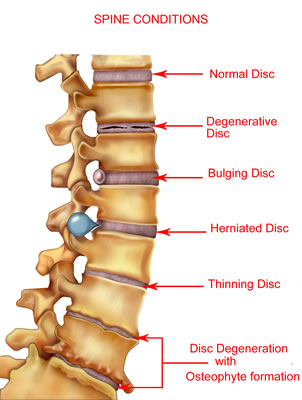DEGENERATIVE DISC DISEASE
Degenerative disc disease refers to a syndrome in which a painful disc causes chronic low back pain. The condition generally starts with a torsional (twisting) injury to the disc space. The injury weakens the disc which with further motion can result in pain often described as a generalized low backache. The disc simply cannot hold the vertebral segment together as well as it used to. Furthermore, the inflammatory proteins inside the disc that become exposed and irritate the local area, produces low back pain.
Unlike the muscles in the back, the disc does not have a blood supply and therefore cannot heal itself and the painful symptoms of degenerative disc disease can become chronic. While it is rare that low back pain from degenerative disc disease will progress or increase, the pain will tend to fluctuate and at times may become significantly worse.
The Degenerative Process:
It is important to note that disc degeneration is part of the natural process of aging and does not necessarily lead to low back pain. MRI scans have documented that approximately 30% of 30 year olds have signs of disc degeneration on MRI scans even though they have no back pain symptoms. It must therefore be stressed that not all degenerated discs that are seen on MRI scans are pain generators.
As the population ages, it is even more common for individuals to have signs of disc degeneration without pain, and by the time an individual reaches 60 years old, disc degeneration is an expected finding on an MRI scan. In fact, the incidence of low back pain actually declines as we age, despite the fact that our discs are degenerating. A fully degenerated disc no longer has any inflammatory proteins (that can cause pain) and usually collapses into a stable position. While many people over the age of 60 have degenerated discs, it is highly uncommon for them to suffer from degenerative disc disease.
Options of Degenerative Disc Disease Treatment:
For most people, degenerative disc disease can be successfully treated with conservative care. Most patients will experience low-grade continuous but tolerable pain that will occasionally flare (intensify). The frequency and intensity of the flares can be managed with conservative measures (non-surgical):
- Improve body mechanics.
- Physical Therapy: hamstring stretching, dynamic lumbar stabilization exercises, low-impact aerobic conditioning…
- Medications: Non-prescription medications, such as NSAID’s and acetaminophen, may be helpful in alleviating low back pain, and stronger medications, such as oral steroids or pain-killers, may be prescribed to treat severe flares.
- Epidural Steroid Injections:
For patients who are unable to function because of the pain, or who are frustrated with their activity limitations, lumbar spinal fusion surgery is an option. Fusion surgery works because it stops the motion at a painful motion segment. However, surgery should be contemplated only after conservative measures fail.

Contact Us
13710 Olive Boulevard (Primary Office)
Chesterfield, MO 63017
Telephone: 314-469-PAIN (7246)
Fax: 314-469-7251
Exchange: 314-441-6965 (for after-hour Emergencies Only)
Hours:
Monday thru Friday
8:30 AM – 4:30 PM

